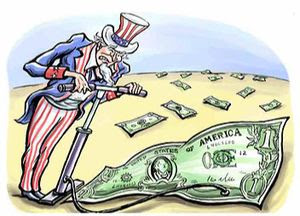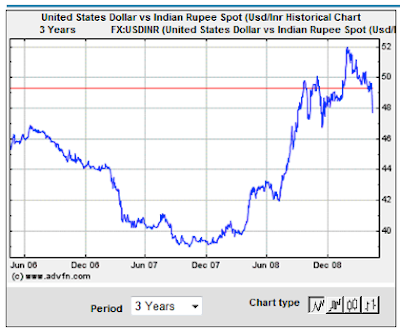 Sudden fall in unemployment numbers in US had raised speculations that Federal Reserve may end its easy money policy sooner. Accordingly, US Dollar started gaining against other major currencies including Indian Rupee. Poor monsoon data and negative FII inflows also put pressure on INR in the beginning of the week.
Sudden fall in unemployment numbers in US had raised speculations that Federal Reserve may end its easy money policy sooner. Accordingly, US Dollar started gaining against other major currencies including Indian Rupee. Poor monsoon data and negative FII inflows also put pressure on INR in the beginning of the week.Gold and other commodities were also seen losing against US Dollar. Bursting of bubble in Chinese markets also added pressure on the metals.
However, Federal Reserve, in its FOMC minutes on Wednesday, said that the easy money policy will be continued for an extended period of time and it would pump in $300 billion dollars (around Rs.15,00,000 lacs) into the market by October 2009. This statement revived positive sentiments in the global markets.
Positive GDP numbers in Germany also added to the bullish sentiments of the markets. Euro gained in a big way against US Dollar. Gold also had a spurt against USD rising to $963. Fall in South African Gold production also helped the Gold prices to firm up against US Dollar.
Indian Rupee also turned into positive trend and went below 48 levels. Surprise rise in IIP numbers (India) for the last month also helped INR to strengthen against USD. However, heavy demand for Dollars from the importers checked any major appreciation for Rupee.
Worse than expected US Consumer confidence data released in US on Friday indicated that the recession is far from over and the US Dollar gained against other major currencies accordingly. Gold also fell to $948 levels.
US Dollar may begin the next week with some gains against other major currencies including Indian Rupee. Local currency markets will also look for the trend in the equity markets particularly the FII inflows. For the next week, Rupee may trade between 48 and 49 levels.
There is a major risk of downgrading of Indian Rupee in case our government increases its borrowing programme for the current fiscal year to accommodate the possible drought relief measures.
Gold may face a strong resistance around $963 & $ 980 levels. Breaking the above two levels may take the prices to $1000 levels. In Rupee terms, MCX Gold may face resistance around 15020 and 15200 levels.
Indian stock markets are now cautious about the impact of poor monsoon on the overall GDP. It is expected that there may be an impairment of around 1.00% in the overall GDP for the current year due to poor monsoon. Further, reduced crop production will add to the pressure on the food inflation which is already at a high level.
Overall outlook for a normal monsoon seems to be a distance dream now and the short fall is likely to be over 25%, sounding weakness for rural demand prospects.
Still the broader trend of stock prices has been inline with Dow futures and the net inflows from FIIs, who were once again net sellers in cash market except for Thursday. The gains were broad based and the mid and small cap stocks gained more than the large cap stocks. There was renewed interest from domestic institutions and they gave strong support at every low, absorbing most of the net sales from FIIs and public.
Stock markets are quite happy about the IIP data and there is view that impact of poor monsoon may be nullified by a strong growth in industrial sector. However, personally I would like to see the trend of IIP numbers for some more months to take a firm view on the revival in the industrial sector.
Next week, Indian Stock markets will be looking for direction from its Asian peers and US Dollar movement. As said earlier, Nifty may face resistance around 4610 & 4730 levels and find support around 4520 and 4480 levels. Firm breaking above 4730 levels may indicate a new bull cycle whereas a complete fall below 440 may point towards a steep fall.
Wishes for a happy week ahead.




